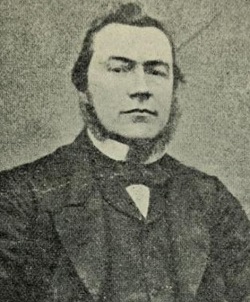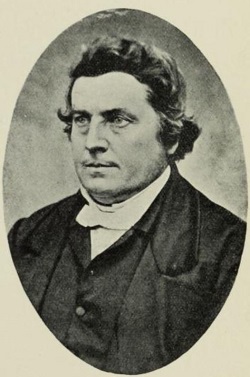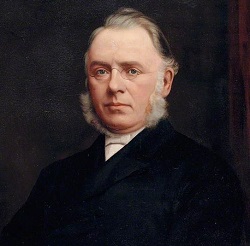1859 Welsh Revival (27 revivals)


Introduction
Wales has been known as the “Land of Revivals.” Between 1762 and 1862 there were at least 15 outstanding revivals in Wales. In between those periods of revival, the people went into the typical decline of coldness and indifference to their own spiritual condition, as well as becoming indifferent toward the lost all around them.
When revival did come to Wales, men preached with an extraordinary unction. That is what happened during the revival of 1859, and it led to the conversion of around 110,000 people.
Two Prominent Revivalists
The renowned revival historian, J. Edwin Orr, indicated that “the Welsh revival of 1859 was independent of great personalities.” Yet we know that every revival is started by a person God uses to initiate and create the spark that gets the revival fire burning.
Some say revivals are dependent on the sovereignty of God, and that is true, but God always sovereignly works through His people. And if anyone would be credited as having been used by the Lord to light the fires of the 1859 revival in Wales, it would have been Humphrey Rowland Jones.

Humphrey Jones
Humphrey Rowland Jones (1832-1895)
Humphrey Jones was with the Wesleyan Methodists. He had immigrated to the United States in 1854 and conducted ministry among Welsh settlers in Wisconsin and New York with tremendous success.
Having witnessed the effect of the 1857 Fulton Street Prayer Revival that spread across the United States, he returned to Wales in June of 1858 with the intention of seeing revival happen there.
A warning to revivalists: during the 1859 revival, Jones had a very powerful ministry at the beginning, and was effective in leading many to Christ, as well as inspiring other revivalists. But his fame evidently got the best of him, and his pride set him up for demonic deceptions, designed by Satan to bring the revival to an end. Jones began proclaiming he was receiving prophetic revelations, and one of those revelations was that on a certain day in July 1859, the Holy Spirit was going to descend in visible form in the Welsh Chapel in Aberystwyth at 11 a.m. It was expected that this was to be the commencement of the Millennial Reign of Christ. When this didn’t happen, it led to Jones having a nervous breakdown, being hospitalized, and finally returning to the United States where he died in 1895.

David Morgan
David Morgan (1814-1883)
Morgan, a carpenter by trade, did not have any formal ministerial training. He received his education by reading books of Puritan authors. He was ordained by the Calvinistic Methodists in 1857.
During the early stages of the revival, Morgan had been skeptical of the revival meetings that were being held by Humphrey Jones, until he heard Jones preaching at Pont-rhyd-y-groes, at the end of September 1858. After that service Morgan met with Jones and they agreed to work together to conduct prayer meetings and preaching services throughout Cardiganshire (now Ceredigion).
Morgan had begun praying for a blessing from God on his ministry, and a dramatic and supernatural gift was granted him, which he described as being able to “remember everything of religious nature that I had ever learnt or heard.”
This total recall, being accompanied by a fresh power, enabled Morgan to remember hundreds of names and the details of their spiritual conditions. Through Morgan’s ministry, he saw churches awakened, sinners saved, and the revival spread throughout Wales.
It was said that when the revival declined, Morgan “returned to the rank of ordinary preachers.” His son testified of this by saying:
This astonishing endowment of memory was revoked as suddenly and unexpectedly as it was conferred. One night, in less than two years time, he went to sleep in possession of it, and when he awoke—it was gone!
Condition of the Churches Prior to the Revival
► The Church was formal, cold, and unattractive to the world.
► Sinful practices were rampant and carried on openly without any sense of shame.
► They were oblivious of their mission to the world.
► Prayer meetings were not burdened for the souls of the unconverted.
► Preaching was theoretical and formal.
► They were orthodox in their beliefs but ineffective in their witness.
Extraordinary Prayer
Reports from the revivals in the United States (1857 Hamilton, Ontario Revival; 1857 Fulton Street Prayer Revival) stirred the Welsh people’s hearts and drove them to their knees, pleading with God for a similar outpouring in their own land.
Prayer meetings were numerous and could be found in churches throughout the land. Often congregations would unite with one another, to inspire and encourage each other in their prayers. There were even prayer meetings conducted by young people 10-14 years of age.
Prayer was the kindling used to initiate the revival, and it was the fuel used to keep it going as long as it did. There were prayer meetings in churches and chapels, on the tops of mountains, at places of employment before a shift began, during the lunch break, underground in the lead mines, and in the slate quarries in North Wales—even when the men were on strike!
What Happened
By the end of December 1858, David Morgan was already witnessing an awakening in his ministry. His preaching took on a prophetic quality, and during his sermons he would at times make comments that appeared to be totally unrelated to his text or the topic he was preaching on, yet it was what the Holy Spirit wanted to speak to certain individuals present.
On New Year’s Day, 1859, Morgan preached at Devil’s Bridge. An elderly minister having been present described the service:
The evening service was terrible. So near was the revivalist to his God, that his face shone like that of an Angel, so that none could gaze steadfastly at him. Many of the hearers swooned. On the way home I dared not break the silence for miles. Towards midnight I ventured to say, ‘Didn’t we have blessed meetings, Mr. Morgan?’ ‘Yes.’ he replied; and after a pause, added, ‘The Lord would give us great things if He could only trust us.’ ‘What do you mean?’ I asked. ‘If he could only trust us not to steal the glory for ourselves.’ Then the midnight air rang with his cry, at the top of his voice, ‘Not unto us, O Lord, not unto us, but unto Thy name give glory.’

There were 15 revivals that occurred in Wales between 1762 and 1862. The image indicates where and when. Right click on the image to open for a better view.
February 1859
In February, Calvinistic Methodist meetings were held in Aberaeron. The churches had been united to pray for God’s blessing upon the meetings. David Morgan was scheduled to preach.
Some of the ministers were opposed to Morgan and even hostile to his having been asked, and they attended his first meeting with an antagonistic spirit. But after the service all opposition was quenched, giving tremendous freedom for Morgan to preach even more powerfully in the second meeting.
A witness recorded the service like this:
The revivalist stood in the pulpit and glanced around the audience, gazing more especially at the crowd of young people in the audience. That gaze was terrible. Hardly anyone in the gallery could endure it. With one impulse they bent their heads like a sensitive plant touched.
By the end of the week, 40 people joined the church at Aberaeron, and by the end of the revival in 1860, about 200 had joined the church at that location. Soon many parts of Wales would experience a powerful outpouring of the Holy Spirit.
The news of the meetings in Aberaeron spread throughout Wales, and Morgan’s schedule was filled with invitations.
Morgan and Jones were but two of the many revivalists. The Holy Spirit had used many men throughout the region, bringing new life into dying churches.
Testimony of the Presence of God
Following one of David Morgan’s services, Thomas John, a resident of Cilgerran, was in the field outside the church, contemplating what he had just witnessed. A friend approached and asked:
What a glorious sight that was, when the thousands were engaged in silent prayer at Mr. Morgan’s request! Did you ever see anything like it, Mr. John?” He answered solemnly, “I didn’t see one of them: I saw no one but God. I am going home,” he said suddenly. “How terrible is this place! It is too terrible for me. My flesh is too weak to bear this weight of glory.”

Thomas Charles Edwards
Testimony of the Principal of the University College of Wales
Thomas Charles Edwards, in June 1859, was present in a revival service in Bala. This is his testimony of how it changed his life.
Here came two plain men to Bala and preached Christ simply, without fuss, without much education or eloquence, but they had more. Eternity came into the service; Heaven came into the place. The change I experienced was sufficient evidence to me of the divinity of Christianity. I was previously a lump of damnation and in that service I became a new creature.
Testimony from 1860
A Thomas Phillips wrote in January 1860, concerning the revival’s power in Llangernyw, saying:
Religion and its concerns are the chief topics of conversation throughout the neighbourhood. Drunkenness is diminishing, and other sins seem to die away. The very countenances of the young people seem changed… those who never attended the sanctuary now attend the prayer-meetings. There is a visible change in the converts – many of them weep almost constantly – are hardly able to sleep at night.
Testimony of Sir Henry Jones
It was a Sunday night of which he writes:
The evidence of the presence and power of the Spirit was overwhelming. Men and women were, quite genuinely, beside themselves with religious excitement. They broke out in the services, glorifying God by the help of hymns and verses, and not infrequently in language of their own which, owing to their exalted condition, was sometimes marvellous in its power and beauty. Their voices mingled together in a confusion that usually put the preacher to silence, and, not seldom, lasted far into the night. Often, during those months, did I crouch in the bottom of the pew in order to escape the waving arms of my grandmother noted for the depth and devotion of her religious life. And I, occasionally, watched strange scenes amidst the excitement. For instance, I saw a farm labourer, a very shoddy character in fact, on his knees in the big pew, beat in the panels of the pulpit with his bare fists; and I watched the finest of the church elders, one of the ablest men I have ever met, go from end to end of the chapel and up and down its aisles, on his knees praising God all the time and manifestly in the power of an overwhelming force.

This map shows where the revival began before it spread throughout Wales. Pictured is the northern part of the county then known as Cardiganshire (now Ceredigion).
Characteristics of the Revival
► Prayer—this was the preliminary effort that sparked this revival.
► Powerful Preaching—the revival wasn’t left to prayer alone. There was powerful preaching that was used to inspire and motivate the congregations, as well as to call sinners to salvation. These sermons were not designed to make those assembled feel comfortable. These ministers preached sermons that called people to examine their lives, and they minced no words.
► Purpose for Attendance—people did not attend church to have their needs met. The Christians came as worshippers to glorify God, and the sinners came seeking a Savior.
► New Evangelistic Measures—most of the Welsh people had been schooled in Calvinism, which lifted the sovereignty of God to such great heights that it was as though there was nothing men could do to initiate revivals, nor to compel a person to make an immediate decision for Christ. This revival changed things, with the revivalists calling for immediate decisions for Christ.
Results of the Revival
► Conversion numbers were not gathered like they are today. During this era, the number counted were those who made a profession of their faith in Christ and were added to church membership after having demonstrated evidence of a changed life.
► 110,000 were converted and became members of the churches, of all denominations. These are the increases in memberships the denominations reported:
…• Calvinistic Methodist: 36,000
…• Congregational: 36,000
…• Baptists: 14,000
…• Wesleyans: 5,000
…• Church of England: 20,000
► The number that backslid, or relapsed, was not more than one in every fifty.
► The people said every day was a Sunday.
► A missionary spirit possessed the churches.
► Ministers were anointed with a fresh zeal.
► There was more harmonious cooperation among the denominations.
► Follow-up of new converts was taken seriously. New Christians were taught that excitement was not conversion.
► Although a total abstinence of alcohol was not mandatory for membership in any of the churches, it was recommended as a safeguard for themselves and as an example to others.
► Before the revival most of the workers in the lead mines were drunks. After the revival, they never started their shift without a prayer meeting underground.
► All denominations were moved to the core. Very few districts were left unvisited by the power of God, and the revival produced a blessing that lasts in the memory of the Welsh national consciousness.
► People did not merely become regular attenders following their conversion; they were transformed, with the sins of drunkenness, domestic violence, and immorality all put behind them.
► There was a striking decline in the number of criminal cases brought before the courts.
► Prior to the revival only Church of England members were admitted to universities. With the increase of membership of Welsh people in Non-Conformist churches (Methodist, Baptists, Wesleyan, etc.), the Non-Conformists gained more political recognition, and the Church of England was disestablished in Wales, giving the Anglican Church nor more status than any other church.
► Welsh communities in Liverpool and other locations of England were also affected by the awakening.
► During the same period there were remarkable outpourings of the Spirit in Ulster, Scotland, and England.
► Charles Spurgeon experienced revival in his New Park Street Ministry.
► It might be said that 1859 was the last UK-wide revival.
Primary Sources
► Revival Comes to Wales by Eifion Evans
► The ’59 Revival in Wales by J. J. Morgan
► The Welsh Revival: Its Origin and Development by Thomas Phillips
Secondary Sources
► 1859 Welsh Revival by Derek French
► An Eyewitness to the 1859 Welsh Revival by Welldigger
► Revival Melodies by R. H. Meredith
► The 1859 Revival by Gwyn Davies
► The 1859 Revival in Wales (Part 1) by Guy Davies
► The 1859 Revival in Wales (Part 2) by Guy Davies
► The 1859 Revival in Wales (Part 3) by Guy Davies
► The History of Revival in Wales in the 19th Century by G. Campbell Morgan
► The Build-up to the 1859 Revival in Wales by Welldigger
► The Power of Prayer by Samuel I. Prime
Videos
► The 1859 Welsh Revival by Hope Reformed Baptist Church
► The Welsh Revivals of 1859 and 1904 by AO Vision
Return to List of Revival Stories
Chet & Phyllis Swearingen:
Office: (260) 920-8248
romans1015@outlook.com
Beautiful Feet
P.O. Box 915
Auburn, IN 46706

